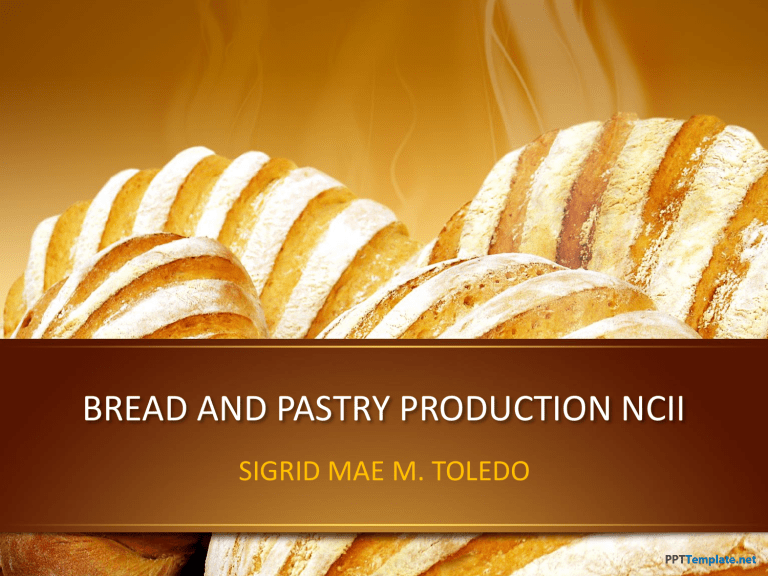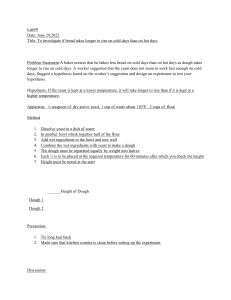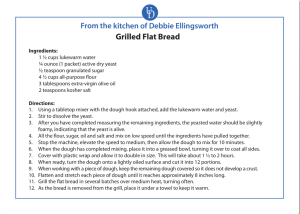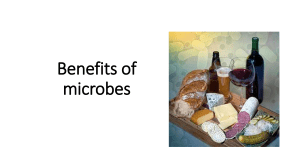Bread & Pastry Production NCII: Tools, Ingredients, Techniques
advertisement

BREAD AND PASTRY PRODUCTION NCII SIGRID MAE M. TOLEDO Tools • Spatula • small spatulas are used to remove muffins and molded cookies from pans which are five to six inches long and about one inch wide. Large spatulas are used to apply icing or frosting cakes. • Flour sifter • one form of sifter has several sieves for sifting flour. • Wooden spoon- this is known as a mixing spoon. It comes in various sizes table for different types of mixing. • Scraper- this is a rubber or pliable plastic scraper used to remove sticky ingredients in the mixing bowl. • Paring knife- this is used to pare or cut fruits and vegetables into different sizes. • Pastry Wheel - it has a blade knife used to cut dough when making pastries. • Pastry blender - a tool with handles and wires, it is used to cut fat or shortening when preparing pies biscuits or doughnuts. • Biscuit and Doughnut cutter - this tool is used to cut different shapes of biscuits and doughnut. • Mixing Bowl- it comes in graduated sizes and has sloping sides. Use for mixing the ingredients • Cutting Tools - these consist of chopping board and a knife and are used to cut glazed fruit, nuts or other ingredients in baking • Kitchen Shears - these are used to slice/cut rolls and delicate cakes or other juicy foods. • Baking Paper - grease proof, this paper is for lining cakes, making piping and wrapping food items. • Measuring Spoon These consist of a set of measuring spoons used to measure small quantities of ingredients. • Measuring glass - used to measure liquid ingredients. • Measuring cups - a set of measuring cup used to measure small amount of dry ingredients. • Rotary Egg Beater - this is used for beating eggs or whipping cream. • Grater and Shredder These are use to grate or shred chocolate, cheese, fresh coconut and other fruits. • Rolling Pin - This tool is used to roll or flatten paste or dough. • Baking Pans - they are glass or metal containers for batter and dough which come in various sizes and shapes. • Pastry Cloth and Rolling Pin Covers - They are used to ease the kneading or flattening dough. • Pastry Bag- it is a funnel shaped container of icing or whipped cream and is used to force food thru a pastry tip. • Pastry Tip - This is a pointed metal or plastic tube, attached to the opening of the pastry bag and is used to form desired designs. • Pastry Brush - is used to grease pans or to brush the surface of pastries and bread. • Dough Cutter - used in cutting/dividing the dough • Double Boiler - the lower section holds boiling water and the upper section holds food that must be cooked at low te • Coupler - this is used in tighten the pastry tip to the pastry bag. • Timer - Used to time bake products, the rising of yeast and to check the doneness of bread and determine mixing time. • Oven Thermometer used to determine the hotness of the oven. Equipments • Convection ovens – used in baking bread. • Gas Range - use in baking and cooking food. • Deck of Cabinet - this is used in baking bread. • Proofing box - this is used in proofing bread. • Kneader/Roller-use in kneading a dough. • Dough Mixer - this is used in mixing the dough. • Upright Freezer - this is used in, freezing ingredients and bread. • Kitchen Aid - it is used in different baking procedure to beat, stir blend ingredients. • Refrigerator - used in chilling ingredients. • Weighing Scale - This equipment is used to measure large quantities of ingredients. Keeping Equipment Clean 1.Use clean and dry rags to wipe and clean equipment. 2. Air dry equipment to prevent rust corrosion and accumulation of dust. 3. Wash and dry the utensils before storing them. 4. Clean and store away the mixer and other hand tools after use and dry well before storing. Wash the detachable parts with soap or detergent and dry very well before storing. 5. Remove grease, oil and other matter that have hardened on equipment with a brush or cloth dipped in light detergent solution. 6. Brush cloth is more appropriate to use than a steel brush in removing flour and powder utensils. 7. Use a stiff brush or steel wool and hot detergent in water to keep pots, pans and other equipment. 8. Rinse the utensils in a very hot clean water to sterilize them. 9. Clean the refrigerator with soap water. 10. Pans with food that stick on them and best soaked in cold water before washing A. Wheat Flour- It provides the structural framework of bread. • Bread Flour- is fairly high in protein content and is sometimes called “Hard Flour”. It has 12- 14% gluten or protein content. This type of flour is used chiefly in making yeast bread or lean bread. • All-Purpose Flour- this is called “Family Flour” because it serves the general purpose in baking. It has 10-11% protein content. This type of flour is used in certain cakes, pastry, cookies, rolls and other breads. • Cake Flour- known as “Weak Flour” and this is the whitest among the flour. It is low in protein and gluten content, 7-8%. It is used for delicate fine- texture • Self-Rising Flour- it has leavening agent as sodium bicarbonate or baking soda and salt that were added to it in proportion desirable for home baking. • Whole Wheat Flour- contains the whole grain or graham. It does not keep as well because of its fat content which tends to get rancid during storage. Pastry Flour- it is made from soft wheat flour. Also white flour with characteristics midway between cake and all-purpose flour. It has a lower percentage of protein and used in pastries and cookies. Three M ajor Functions of Wheat Flour • 1. It provides structure and framework for baked products because of its protein and starch contents. 2. It is responsible in providing structure by the gelatinization process which takes place in the oven. 3. It contributes to the characteristics of the finished product: crust color, texture, volume, crumb, color, grain and taste. B. Liquid- It is plain water, milk or fruit juices in baking. • 1. Water Functions of Water a. It dry substances which are its main function in baking b. It dissolves soluble substances as salt, sugar, dry milk, etc. c. It wets and swells starch d. It promotes leavening action in the form of steam. 2. Milk- It is a basic liquid supply for dough or cake mix. Functions of Milk a. It improves taste, flavor and color of the product. b. It increases water absorbing capacity of dough c. It increases yields. C. Eggs- They are important in baking because an egg represents about 50% of the total cost of the ingredients used in cake production. Uses of Eggs in Baking • a. Leavening- the protein of egg when this is properly beaten will help firm structuring of batter and dough. b. Color- the egg yolk provides the desirable yellow color which gives your products its appearance. c. Flavor- the fat and other nutritive contents of egg and flavor to your product. D. Shortening- It is defined as fat that increases the tenderness of a product.It comes in the form of butter, margarine, vegetable oil. • Uses of Shortening in Baking a. The creaming ability of fats is important for the socalled “sugar-butter” method of mixing. b. It contributes to the tenderness, richness, flakiness, moisture, color and flavor of baked good. E. Sugar- It is a sweet soluble, crystalline organic compound belonging to the carbohydrates group of foods. It gives taste and tenderness to bread. • Types of Sugar a. Granulated Sugar- this type of sugar is applicable to all types of baked products because of its fine crystals. b. Confectioner or Powdered Sugar- it contains approximately 3% cornstarch to prevent lumping. This is primarily used in cake icing. c. Brown Sugar- It contains caramel, mineral and moisture. It also contains molasses and has not been perfectly purified Purpose of Sugar in Baking 1. To add sweetness in baking 2. To give crust color 3. To create tenderness and fineness of texture by weakening the gluten structure. 4. To act as creaming agents with fats 5. To increase keeping qualities by retaining moisture F. Leavening Agent- It is gas added or produced during the mixing and or heating of batter or dough. It makes the mixture rise to produce a light and porous product. 3- Types of Leavening Agent 1. Physical Leavening Agent- This includes air and steam. Air is incorporated through sifting, beating,mixing, folding and creaming. 2. Biological Leavening Agent- This includes yeast which produces carbon dioxide. It makes the dough rise. 3. Chemical Leavening Agent- The usual agent that fall under this type are baking soda, baking powder and cream of tartar which help increase the volume of baked goods Uses of Leavening Agents in Baked Products 1.Leavened baked products are light and therefore easily chewed. 2. Baked goods made with leavening agent have open or more porous grain digestive juices come in contact with the food more readily. 3. Baked products processed of leavening are more palatable and appetizing. Other Minor Ingredients 1. Salt Uses of salt a. It makes food tastier b. It helps control yeast action (fermentation) especially in dough processing. c. It strengthens the gluten of dough. d. It aids in preventing the formation and growth of undesirable bacteria in yeast. Chocolate and Cocoa • They are derived from cocoa or cocoa beans roasted and grounded, and the resulting product is called chocolate liquor, which contain a white or yellowish fat called cocoa batter. Spices • They are used in bakeshop line in cinnamon, nutmeg, mace, cloves, ginger, etc. They are used in small quantities and measured by weight. • Extracts - they are flavorful oils and other substances dissolved in alcohol. Examples are vanilla, lemon and bitter almond. Substitution of Ingredients 1 cup Fresh milk ½ cup evaporated milk + ½ cup Water 1 tablespoon All purpose flour ½ tablespoon cornstarch 1 cup cake flour, sifted 7/8 cup all-purpose flour, sifted 1 cup all purpose sifted flour minus 2 tablespoon 1 teaspoon baking powder ¼ teaspoon baking soda + ½ cup fully soured milk 1 tablespoon active dry yeast 1 package (7 gm.) dry yeast 1 whole egg egg yolks or 3 tablespoon thawed frozen egg 1 egg white 2 tablespoon frozen egg white 1 cup self-rising flour 1 cup all-purpose flour plus 1 teaspoon baking powder and ¼ teaspoon salt Types of Bakery Products Breads Bakeries produce a wide variety of breads including rye, Italian and pumpernickel. Breads are one of the oldest forms of food in the world and are made by baking dough, a flour and water mixture. Other ingredients such as salt, fat, milk, sugar, baking soda and yeast can be added. Breads come in a variety of forms, including rolls and loaves. Other common ingredients in bread include nuts, seeds and vegetables. Doughnuts • Doughnuts provide a tasty snack and can be eaten for breakfast. Usually sweet and deep fried, doughnuts come with a hole in the middle or as a solid piece filled with items such as jelly, creams or custards. Doughnuts can be baked in an oven instead of deep fried. Common doughnut toppings include powdered sugar, glaze and caramel. The two main types of doughnuts include yeast and cake. Yeast doughnuts are lighter and fluffier. Cake doughnuts tend to be heavier. The majority of doughnuts have a round shape. Bagels • Bagels, popular breakfast items, are usually made of yeast wheat dough and come in the form of a ring. Bagels have a thick and tough exterior that is crisp and often browned. Common bagel toppings include poppy and sesame seeds. Most bakeries carry bagels, although bagel shops specialize in bagels only. Pies • Bakeries sell pies as dessert items. A pie is a baked dish consisting of layers of pastry dough that form a shell and have sweet or sour fillings. Pies can also be filled with meat and eaten as a dinner, however such pies are rarely found in bakeries. Some traditional varieties of pies sold in bakeries include apple, strawberry, blackberry, cherry, cream, custard, key lime and lemon meringue. Pastries • Pastries refer to baked goods made with ingredients that often include butter, sugar, shortening, flour, baking powder and eggs. Pastries, higher in fat content than breads, include small desserts and quiches. Other types include Danish pastry and croissant. Preparing Variety of Bakery Products • Quick Breads • Quick bread is leavened by using baking powder or baking soda. They are call quick breads because they are prepared in short time compared to yeast bread. Examples are muffins, biscuit, waffles, griddle cake, doughnuts and fritters. Classification of Quick Bread 1.Pour or thin batter- it is a batter that can be poured in steady steam, usually prepared using 1 ½ to 2 cups liquid to 2 cups flour. Quick breads of pour or thin batter type are popovers, griddle cake, and waffles. 2. Drop-batter or stiff- they are pour in heavy drop usually 1 cup liquid to 2 cups flour. Quick breads of drop batter type include muffins, cakes, fritters, biscuits, cookies, and fruit and nuts loaves. 3. Soft dough- it is sticky and can be rolled and cut easily. It is usually uses ¾ cups liquid and 2 cups flour. Soft dough includes doughnut and some biscuits Functions of the Different Ingredients in Quick Bread Making • Flour - It provides the structural framework of quick breads. The starch of the flour contributes to the golden color of the crust. • Liquid - It may be plain water or milk, fruit juice, coffee, chocolate, molasses and eggs. • Sugar - It gives taste and tenderness to quick bread. • Leavening agents - It consist of steam, air and carbon dioxide which are produced during the preparation process served. Methods used in Mixing Batter and Dough • • • • 1.Pastry Method- it is all dry ingredients that are sifted in a bowl, the shortening is cut into the dry ingredients. Liquid is finally added and the dough is continually mixed until the ingredients form together. This is generally used in preparing pastries and biscuits. 2. Conventional Method- the shortening and sugar are creamed together until the mixture becomes fluffy. Beaten egg whites are added to the mixture. Sifted dry ingredients are added alternately with liquid ingredients to the creamed mixture, beginning and ending with dry ingredients. 3. Muffin Method- this blends all dry ingredients together. Eggs are beaten in a separate bowl; melted shortening or oil is combined. A well is made at the center of the sifted dry ingredients. The liquid mixture is gradually added into the well. Proper mixing is needed in muffins to achieve a pebbed crust. Some batters require less mixing, but a basic recipe takes not more than 25 strokes. 4. One Bowl Method- this makes use of an electric mixer. Melted shortening or oil, dry ingredients are and most of the ingredients are blended together. Beaten eggs are added at the last stage of mixing when all the ingredients are already combined and blended. Yeast Bread • Yeast bread is leavened with yeast. Yeast used is of two kinds, compressed yeast (for moist cake) and the most commonly used the dry active yeast. The dough is prepared by stirring, beating and kneading to mix the mixture thoroughly and develop gluten in flour. • Compressed yeast is a collection of yeast organism packed in most yeast food material. The activity of the yeast organism is slowed by low temperature, so compressed yeast should be stored under refrigeration when it is to be kept for more than a day. • Dry Active yeast the organisms are in dormant condition. As such it has the ability to establish a resting stage in which it remains alive for several months with proper with proper storage conditions, preferably cool and dry. • 1. Regular Yeast Dough Product a. Lean dough products- They are low in fat and sugar. Hard crusted bread and rolls like French breads, Italian breads, Kaiser Rolls and pizza • 2. Rich Dough Products- contain higher proportion of fat, sugar, and eggs. • Example: • 1. Non-Sweet breads and rolls-high fat content but low sugar. 2. Sweet rolls, coffee cake and tea rolls- high in fat, sugar and eggs and with fillings and toppings. • Example: Non-Sweet rolled-in dough; croissants • Sweet rolled-in dough: Danish pastry M ixing M ethods • Mixing yeast dough has three main purposes 1. To combined all ingredients into uniform, smooth dough 2. To distribute the yeast evenly throughout the dough 3. To develop gluten Steps in Yeast Dough Production 1. Scaling ingredients 2. Mixing 3. Fermentation 4. Punching 5. Scaling 6. Pounding 7. Benching 8. Make – up and panning 9. Proofing 10. Baking 11. Cooling 12. Storing Steps in Yeast Dough Production • • • • • • • • • • • • 1. Scaling ingredients 2. Mixing 3. Fermentation 4. Punching 5. Scaling 6. Pounding 7. Benching 8. Make – up and panning 9. Proofing 10. Baking 11. Cooling 12. Storing Basic Bread Making Operation • • • • • • • • • • • • 1. Weighing of Ingredients 2. Mixing of bread dough 3. Fermentation 4. Make-up 5. Dividing or scaling 6. Rounding 7. Intermediate Proofing 8. Molding 9. Panning 10. Final Proofing 11. Baking 12. Bread Cooling The following methods are used to mix dough in bread making: 1. Straight dough method- It is one of the most common methods that use all of the ingredients at one time to make the dough. All the flour is added without a preliminary fermentation period. 2. Sponge dough method- The part of the flour that is mixed with liquid and all of the yeast to make a drop batter first which is set aside to rise bubbly. The rest of the ingredients are blended and the mixture is treated like straight dough. 3. The “no knead method” Kneading is not done. Instead the dough is dropped directly into the pan before or after rising of the first period. The products are not as fine as the kneaded dough. Use of the Appropriate Personal Protective Equipment (PPE)/ Cooking Outfit. 1.Pot Holder- this is used in lifting hot objects from the oven. 2. Apron- protects the body from burns and scalds and from food or liquid stains. 3. Hairnet- used to prevent loose hair from dropping into food. 4. Toque- used to hold hair while baking.



